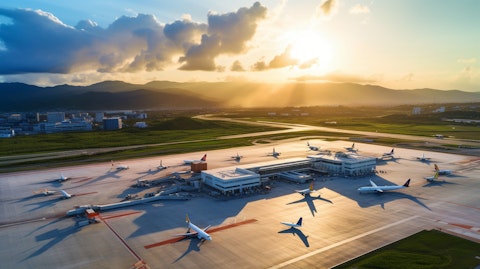Grupo Aeroportuario del Sureste, S. A. B. de C. V. (NYSE:ASR) Q3 2025 Earnings Call Transcript October 23, 2025
Operator: Good day, ladies and gentlemen, and welcome to ASUR’s Third Quarter 2025 Results Conference Call. My name is Latanya, and I’ll be your operator. [Operator Instructions] As a reminder, today’s call is being recorded. Now I’d like to turn the call over to Mr. Adolfo Castro, Chief Executive Officer. Please go ahead, sir.
Adolfo Castro Rivas: Thank you, Latanya, and good morning, everyone. Before I begin discussing our results, let me remind you that certain statements made during the call today may constitute forward-looking statements, which are based on current management expectations and beliefs and are subject to several risks and uncertainties that could cause actual results to differ materially, including factors that may be beyond our company’s control. Additional details about our third quarter 2025 results can be found in our press release, which was issued yesterday after market close and is available on our website in the Investor Relations section. Following my presentation, I will be available for Q&A. As usual, all comparisons discussed on this call may be — will be year-on-year and figures are expressed in Mexican pesos, unless specified otherwise.
Before discussing our results, I would like to begin today’s call with an important strategic development. As recently announced, we entered into a definitive agreement to acquire URW Airports for an enterprise value of $295 million. This transaction marks a significant step forward in ASUR’s international expansion strategy, building our established presence in the U.S., which began with the operation of San Juan Puerto Rico Airport in 2030. URW airports managed commercial programs are 3 most iconic and high-traffic airports in the United States. URW airports manage commercial programs at 3 of the terminals — 3 of the airports in the United States, Los Angeles International Airport with 6 terminals, Chicago O’Hare International Airport at Terminal 5.
And in the case of John F. Kennedy International Airport covering terminals 8 and the upcoming new terminal 1. Together, these terminals process around 14 million enplanements annually. This acquisition provides ASUR with a strategic foothold in the 3 of the largest U.S. air travel markets and strengthens our position in the high-growth nonregulated commercial segment in the U.S. airport industry. The acquisition will be financed by JPMorgan Chase. As with all our strategic decisions, we are approaching this opportunity with a financial discipline and operational rigor that has long defined ASUR’s execution. Closing is expecting during the second half of the 2025. Subject to customary regulatory approvals, we look forward to keeping you updated on our progress in the quarters ahead.
Now turning to our third quarter performance. We serve over 17 million passengers across our airports, with traffic remaining practically flat as continued growth in Colombia and Puerto Rico helping to offset persistent headwinds in Mexico. Starting with Colombia, passenger traffic rose 3% to close to 5 million, supported by a solid 11% increase in international traffic and a modest growth just under 1% in domestic volumes. In Puerto Rico, total traffic was up 1%, reaching over 3 million passengers. Growth was driven by international passengers, which increased nearly 12% year-on-year, offsetting the 0.5% decrease in domestic traffic. In Mexico, traffic declined 1% to nearly 10 million passengers for the quarter. The decrease reflects softer demand, domestic traffic, which was down nearly 2% and international which saw a slight contraction of 0.3%.
Passenger volumes from the United States, our largest international source market decreased just 0.2%, while South America contracted 7.2%. On the positive note, Canada and Europe increased 9.3% and 1.3%, respectively. Looking ahead, we anticipate a more balanced operating environment across our portfolio. In Mexico, we expect traffic to gradually stabilize over the next year as aircraft ability improves. In Puerto Rico and Colombia, we expect continuous positive momentum supported by the healthy international demand and improving productivity. Now turning to review our financial results. As a reminder, all figures exclude construction revenues and costs, unless otherwise noted. Comparisons are all year-on-year unless otherwise noted. Total revenues increased in the mid-single digits, reaching over MXN 7 billion, driven by growth in Puerto Rico and Colombia.

Mexico at 70% of total revenues posted a slight low single-digit decline with aeronautical revenues practically flat and non-aeronautical revenues down in the mid-single digits. Revenue growth was limited by softer passenger volumes and the stronger peso, which continues to weigh on the U.S. linked revenue streams. Puerto Rico at nearly 18% of total revenues reported revenue growth in the high single digit driven by increases in 5% in aeronautical revenues and 10% in non-aeronautical revenues. This performance reflects positive passenger traffic trends and sustained demand across commercial activities. Colombia, which accounted for a total of [ 30% ] of the total revenues, delivered revenue growth in the high single digits, reflecting a mid-single digit increase in aeronautical revenues while non-aeronautical revenues were up in the high teens.
This good performance was supported by passenger traffic growth and solid — partially offset by the strong Mexican peso. Continue our ongoing focus on commercial development. We added 45 new commercial spaces across our airports over the last 12 months, including 31 in Colombia, 8 in Puerto Rico and 6 in Mexico. This supported a low single-digit increase in commercial revenues as solid growth in Puerto Rico and Colombia was partially offset by a weaker performance in Mexico. On a per passenger basis, commercial revenue rose 1% to MXN 126. By region, Colombia led a 14% increase followed by Puerto Rico, up 10%, while Mexico posted a 4% decline, reaching MXN 144 per passenger. Turning to costs. Total expenses were up nearly 17% year-on-year. By region, Mexico posted a 4% increase, largely due to higher maximum — minimum wages and service costs.
Puerto Rico reported expense increase of nearly 8%, reflecting inflationary pressures and higher operating activity. While Colombia cost increased 76%, mainly driven by an adjustment in amortization method of the concession. Without this increase would have been 5.4%. Lastly, in Puerto Rico and Colombia cost benefited from depreciation of Mexican peso against the U.S. dollar. On the profitability front, consolidated EBITDA declined just over 1% year-on-year to MXN 4.6 billion in the quarter. Puerto Rico and Colombia delivered EBITDA growth of nearly 5% and 10%, respectively, while EBITDA in Mexico declined close to 4%, mainly reflecting lower traffic and higher operating costs. The adjusted EBITDA margin, which excludes construction related revenues and costs under IFRIC 12 declined by 157 basis points to 66.7%.
This reflects lower margin contribution from the Mexican and Puerto Rico operations, where the margin contracted 152 and 151 basis points, respectively. In contrast, Colombia reported an 81 basis points margin expansion. On our bottom line, this quarter was negatively impacted by depreciation of the Mexican peso against the U.S. dollar, which resulted in a foreign exchange loss of nearly MXN 1 billion compared to the reverse effect during the third quarter of last year. Profitability was also affected by the MXN 333 million adjustment in the concession amortization method in Colombia that I just explained. Now moving to our balance sheet. We closed the quarter with a solid cash position of MXN 16 billion, down 19% from December 31, 2024, primarily reflecting dividend payments made during the period.
Our net debt-to-EBITDA ratio remained at healthy 0.2x. In terms of capital deployment, in September, we paid an extraordinary dividend of MXN 15 per share funded from retained earnings. Note that in November, we will be paying an additional dividend of MXN15 per share. Lastly, we invested close to MXN 1.9 billion during the quarter, primarily directed to projects our Mexican airports, including the reconstruction and expansion of Terminal 1 at Cancun Airport, and the terminal expansion in [indiscernible]. In Puerto Rico, we are progressing on the new pedestrian bridge for Terminal A, while in Colombia, we invested in maintenance CapEx. In closing, our third quarter results reflect the resilience of multi-country platform and the value of our disciplined execution amid a more tempered demand environment.
While traffic in Mexico continued to face near-term headwinds, we are encouraged by the ongoing momentum in Puerto Rico and Colombia. We remain focused on advancing on our commercial strategy, investing in infrastructure and maintaining a strong financial profile. These conclude my prepared remarks. Latanya, please open the floor for questions.
Q&A Session
Follow Grupo Aeroportuario Del Sur S A (NYSE:ASR)
Follow Grupo Aeroportuario Del Sur S A (NYSE:ASR)
Receive real-time insider trading and news alerts
Operator: [Operator Instructions]. The first question comes from Rodolfo Ramos with Bradesco BBI.
Rodolfo Ramos: I have a couple, if I may. The first one is in regards to the URW acquisition. Can you shed a bit of light on the economics, revenue per pax, how much EBITDA contribution you’re expecting from these assets on an annualized basis? And the second is on Colombia. Can you elaborate on this adjustment to the concession amortization method that we saw during the quarter, was this a one-off? Or should it be a new level going forward? I don’t know if it has to do something with the economics of your concession title there?
Adolfo Castro Rivas: Thank you for your questions. In the case of URW, I cannot yet share numbers with you until [indiscernible]. In the case of Colombia, basically, what we have done is to change amortization method because in accordance with our estimates, during 2027, we will not receive regulated revenues anymore, and the concession should be over by 2032. So we are aligning amortization in accordance with revenue generation there. And it’s going to be not one-off. It’s going to be from now the same level.
Operator: The next question comes from Emst Mortenkotter with GBM.
Ernst Mortenkotter: I wanted to follow up a little bit on URW. I understand you cannot discuss the financials. But leaving that aside, it seems like a great way to gain some strategic insight into the consumer that goes from your airports to the U.S. I just was wondering if you could discuss a little bit what kind of synergies do you see? Or what is the strategic rationale behind this acquisition?
Adolfo Castro Rivas: Thank you, Anton. Well, basically, the most important for us is to get — to put a foot in the U.S. market. The U.S. market represents 22% of the aviation market of the world. And these terminals are extremely important for the U.S. market. So pulling our name there is extremely important, and this should be the platform for future growth in the United States, probably in the same kind of contracts that we are entering right now. That is the most important thing.
Operator: Our next question comes from Andressa Varotto with UBS.
Andressa Varotto: I have 2 here on my side. The first one is about Motiva Airports that are for sale. We’ve been seeing the news source that ASUR is [indiscernible] interested in this airport. So just wondering if you could provide some more information, if you’re looking, for example, at all of the airports are just a subside of them. And how would the company finance this? And my next question is regarding the traffic trends that you’ve been seeing for Mexico. We’ve been seen recently on news as well that Tulum airport has been facing some cancellations. And if you think that this could help Cancun airport in the near future. These are my 2 questions.
Adolfo Castro Rivas: In the case of Motiva, I cannot comment. In the case of the traffic trends, what I see today, it’s a slow recuperation in the domestic market because of Pratt & Whitney engines, something that should improve in my opinion during the next year. For the moment, the traffic is really weak and the demand is weak in the case of the region. If we see Cancun and Tulum together for the first 8 months of the year, and I’m saying that months because that is the latest public figure or the case of the airport of Tulum. The traffic for the region is a decrease of 3.1%. If we go to the latest month that has been published for the case of the airport of Tulum which is the month of August this year. August versus August last year, the traffic of the region was a decrease of 5.1%. So the traffic is soft. Nevertheless, what you are saying in terms of the recent cancellations to the airport of Tulum.
Operator: [Operator Instructions] Our next question comes from…
Adolfo Castro Rivas: Sorry, could you repeat?
Operator: Our next question comes from Pablo Ricalde. The next question comes from Pablo Ricalde with Itau.
Pablo Ricalde Martinez: My question is related to the [indiscernible] Cancun? Is it still expected to be open around Q3 2026 or there are delays on that construction of that one?
Adolfo Castro Rivas: What we are expecting is to open this new facility during the third quarter 2025 — 2026, sorry.
Pablo Ricalde Martinez: Okay. So as expected.
Operator: The next question comes from Gabriel [indiscernible] with Deutsche Bank.
Unknown Analyst: [indiscernible] Just 2 questions. First, is there any way or some how that capacity allocation from carriers has been shifting from Cancun? And the second one is the decrease in traffic could somehow make the pace of writing the tariffs towards the maximum tariff faster for either this year or next year?
Adolfo Castro Rivas: Well, in terms of capacity, we are not — we’re not seeing a shift in capacity. What we are seeing basically is a weak demand, as I said, from the domestic resulted from Pratt & Whitney and some other elements. And in the case of the U.S., the numbers for the quarter is 0.2% decrease, which is small, but it’s the largest market we have. Let’s see how the winter comes. And I hope that the winter will be very strong in the north part of the Americas, and then they come. Positive side is the case of Canada, which is up for the quarter, and I thought that it will be up during the fourth quarter as well.
Unknown Analyst: And in the case of the traffic that has somehow decreased, that could accelerate the pace on which tariffs are increased up to the maximum tariff?
Adolfo Castro Rivas: No. I don’t see that. Our maximum tax compliance this year should be similar of what it was last year, so more than 99%.
Operator: [Operator Instructions] At this time, we’ll turn the call back over to Mr. Adolfo Castro for closing comments.
Adolfo Castro Rivas: Thank you, Latanya, and thank you all of you again for joining us on our conference call for the third quarter 2025. We wish you a good day, and goodbye.
Operator: Thank you. This does conclude today’s teleconference. You may disconnect your lines at this time. Thank you for your participation, and have a great day.
Follow Grupo Aeroportuario Del Sur S A (NYSE:ASR)
Follow Grupo Aeroportuario Del Sur S A (NYSE:ASR)
Receive real-time insider trading and news alerts




